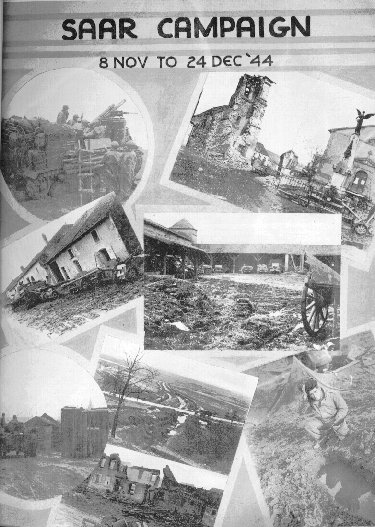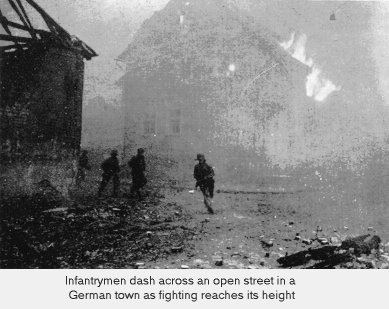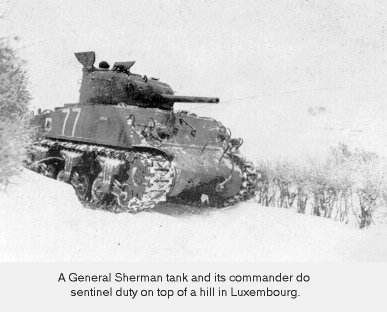Seille River Campaign |
|
Ardennes Campaign |
 |
Chapter III |
 The Fall
offensive of the Third U. S. Army, projecting a drive through to
the Rhine, opened 8 November. The XII Corps with three Infantry Divisions
(26th, 35th and 80th) and two armored divisions, the 4th and 6th, was to
advance generally east from NANCY across the SAAR River south of SAARBRUCKEN.
The Fall
offensive of the Third U. S. Army, projecting a drive through to
the Rhine, opened 8 November. The XII Corps with three Infantry Divisions
(26th, 35th and 80th) and two armored divisions, the 4th and 6th, was to
advance generally east from NANCY across the SAAR River south of SAARBRUCKEN.
A bridgehead was forced across the SEILLE River 8 November by the 80th Infantry Division, and the 6th Armored Division was rushed through the Infantry Division to exploit the breakthrough. Reserve Command was immediately moved northwest to the vicinity of ATTON with a view to crossing behind the foot troops and enlarging the bridgehead to the north if necessary.
This action would have given the 6th Armored more elbow room to break out to the east. It was particularly important that the ridge which the main highway follows from CHEMINOT toward VIGNY be included in the bridgehead. Actually this plan for Reserve Command was never carried out since the 5th Infantry Division, attacking the following day, secured the necessary ground on the north flank to enable the northern command to break out.
Early in the morning of 9 November, Combat Command A crossed the SEILLE
at NOMENY, while Combat Command B crossed at PORT-SUR-SEILLE. Forty-eight
hours after crossing the SEILLE, the Division captured five strongly fortified
towns, advanced five miles on a ten mile front, and destroyed many large
pieces of enemy equipment. The enemy had fortified himself in small
towns along the axis of advance and held doggedly but unsuccessfully against
armored thrusts. Each Combat Command planned to advance in two columns
to reach the NIED,
thus enabling the Division to arrive on a front of about ten miles.
The objective was to secure one or more crossings of a river known to be
at
flood stage.
BITTER, BITTER RAGED THE FIGHT
The enemy had withdrawn across the bridge followed shortly thereafter
by an armored engineer platoon leader, who cut the lead wires from the
demolitions, saving the bridge from complete destruction. As
he completed his mission he was fatally wounded. The crossing at
HAN had been personally led by Combat Command A's commander under a screen
of smoke, as enemy resistance had mounted to a furious pace. Officers
and men had been killed and wounded in great numbers.
At SANRY, Combat Command B's crossing had been made through combined
efforts of tank and infantry teams. Working closely with the armored
command was the 2nd Infantry Regiment of the 5th Infantry Division,
which later used the bridge at SANRY to cross the NIED, and turned north
in its
operation against the fortress city of METZ.
Bridgeheads at REMILLY and BAUDRECOURT (12 November) were established, then the villages of HERNY (12 November) VATIMONT (12 November) and ARRIANCOURT (13 November) were taken from the German defenders under the roughest of action.
Progress on the Division front became painfully slow as enemy resistance stiffened and counterattacks and artillery fire became more vicious. Characteristic of the type of action that occurred in the SAAR Campaign is the battle that took place at LANDROFF, 14-15 November. Tank-infantry forces of Combat Command A entered the village at 1400, 14 November, after destroying exceptionally strong enemy resistance, and established security outposts. Four times during the night the enemy launched counterattacks from the north, employing infantry and self propelled guns, each time with a larger force than before.
As the 6th Armored finished its mission in helping the 80th Infantry
Division in its drive to capture FAULQUEMONT and turned east once more,
a new Corps plan was announced. Advance to the SAAR would be continued
with the 26th and 35th Infantry Divisions abreast in the assault, followed
by the 4th and 6th Armored Divisions. The terrain between the flooded
valleys of the ROTTE and the GERMAN NIED Rivers presented a very narrow
exit to the east. It therefore appeared necessary for the Division
to cross to the south of the ROTTE in order to follow the 35th Division.
Combat Command A was to remain on the north side of the river and Combat
Command B was to move south then east through MORHANGE. When Combat Command
B arrived in the MORHANGE area it found that the 35th Division's advance
northeast had met light resistance. Therefore, Corps
ordered the Division to pass through the infantry the following day
and exploit to the east. On 19 November the Command attacked northeast
and
fought bitterly in four towns to overcome tank ditches, minefields,
AT guns, heavy artillery and mud. The Germans defended every foot of ground
with great determination but the superior will of the Command overcame
this stubborn resistance and the enemy was either killed or forced back.
ANOTHER DAY, ANOTHER VILLAGE TO CONQUER
 Envelopment
tactics were employed to keep the offensive moving as enemy resistance
and weather conspired to hold down qains to a few thousand yards.
However, within the next eight days, at least one village was taken a day:
BERTRING and GROS-TENQUIN (19 November), HEMERING (20 November), HELLIMER
and DIFVEMBACH (21 November), LEYVILLER and ST. JEAN ROHRBACH (22
November), and
Envelopment
tactics were employed to keep the offensive moving as enemy resistance
and weather conspired to hold down qains to a few thousand yards.
However, within the next eight days, at least one village was taken a day:
BERTRING and GROS-TENQUIN (19 November), HEMERING (20 November), HELLIMER
and DIFVEMBACH (21 November), LEYVILLER and ST. JEAN ROHRBACH (22
November), and
FREMSTROF'F (23 November). During the Division's operation in the SAAR, the MAGINOT LINE defenses were penetrated in bitter fighting north of LEYVILLER through 26 November. The forts had been improved and strengthened by the Germans and were being used as an outpost line for the Westwall beyond the SAAR. Cross-country operation by tanks was virtually impossible and only limited advances could be made on the few roads.
The heavy fighting terminated on 5 December. On this date the Division reached the SAAR River north of SARREGUEMINES after a two day battle to secure the plateau of MT. CADERBRONN. The Division faced both east (SAAR River) and north (SIEGFRIED LINE south of SAAR-BRUCKEN) from SAAREGUEMINES to ST. NIKOLAS, the first territory in Germany to come into our possession. This, by far, was the most difficult campaign of sheer "knockdown", "drag-out" fighting the Division had fought to date. During the period from 6 to 19 December, preparations were being made to resume the offensive, when the German counter-attack broke in the ARDENNES.